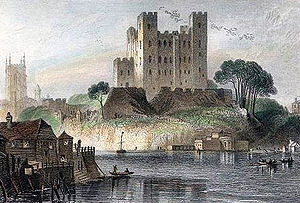|
John de Warenne, 6th Earl of Surrey
 John de Warenne, 6th Earl of Surrey (1231 – 27 September 1304) was a prominent English nobleman and military commander during the reigns of Henry III of England and Edward I of England. During the Second Barons' War he switched sides twice, ending up in support of the king, for whose capture he was present at Lewes in 1264. Warenne was later appointed as "warden of the kingdom and land of Scotland" and featured prominently in Edward I's wars in Scotland. Early life and marriage Warenne was the son and heir of William de Warenne, 5th Earl of Surrey, and Maud Marshal. His mother was the daughter of William Marshal, 1st Earl of Pembroke and widow of Hugh Bigod, 3rd Earl of Norfolk, making Roger Bigod, 4th Earl of Norfolk his elder half-brother. A boy when his father died, Warenne became a royal ward. Peter of Savoy was appointed guardian of his holdings and Warenne was raised at the royal court. In 1247, he married Henry III's half-sister Alice le Brun de Lusignan, a marriage that created resentment amongst the English nobility, who did not like seeing a wealthy English nobleman marrying a penniless foreigner. During the following years, Warenne was closely associated with the court faction centering on his in-laws. In 1254, he accompanied the king's son Edward (the future Edward I) on Edward's journey to Spain to marry Eleanor of Castile. During the conflicts between Henry III and his barons, Warenne started as a strong supporter of the king, switched to support for Simon de Montfort, and then returned to the royalist party. He opposed the initial baronial reform plan of May 1258, but along with other opponents capitulated and took the oath of the Provisions of Oxford. Second Barons' War By 1260, Warenne had joined the party of Simon de Montfort, but switched back to the king's side in 1263. In April 1264, he and Roger de Leybourne were besieged by de Montfort at Rochester Castle. In May of the same year Warenne was present for the Battle of Lewes (fought near his ancestral home, Lewes Castle). After the capture of the king and Prince Edward he fled to the Continent, where he remained for about a year. His estates were confiscated but were subsequently restored. He returned to fight in the campaign which culminated in the Battle of Evesham, the Battle of Chesterfield and the siege of Kenilworth Castle. Warenne served in King Edward I's Welsh campaigns in 1277, 1282 and 1283. In 1282, Edward awarded him the Lordship of Bromfield and Yale in Wales, which was taken from Prince Gruffudd Fychan I and his son Madog Crypl.[2][3] He also started the construction of his castle there named Holt Castle, which was continued by his son William.[4] A good part of the following years were spent in Scotland. He was one of the negotiators for the 1289 treaty of Salisbury and for the 1290 treaty of Birgham, and accompanied the king on Edward's 1296 invasion of Scotland where he commanded the only major field action of that year in the Battle of Dunbar. ScotlandOn 22 August 1296, the king appointed him "warden of the kingdom and land of Scotland". However, Warenne returned to England a few months later claiming that the Scottish climate was bad for his health. The following spring saw the rebellion of William Wallace, Warenne was ordered to lead his army North by the king after initially refusing to return to Scotland. He was defeated by Wallace at the Battle of Stirling Bridge and fled to York. Nevertheless, the king appointed Warenne captain of the next campaign against the Scots in early 1298. He raised the siege of Roxburgh and re-took the town of Berwick. The king himself took the field later that year, and Warenne was one of the commanders during the decisive English victory at the Battle of Falkirk. In the 1300 campaign, Warrene commanded one of four cavalry units in Edward I's army.[5] On 8 August, near the estuary of the Cree, Edward ordered his men and Warenne's to charge at a Scottish force—causing the Scots to flee.[6] Quo warranto?In 1278, Edward I called a parliament at Gloucester with the intention of determining which lords had usurped royal rights—specifically, rights of adjudication—and reclaiming those rights. Walter of Guisborough tells the story that the earl was served a writ of quo warranto ("by what warrant?") as a result of these proceedings. Warenne supposedly responded by drawing a rusty sword and exclaiming that this was his warrant, saying, "My ancestors came with William the Bastard, and conquered their lands with the sword, and I will defend them with the sword against anyone wishing to seize them."[7] Later yearsWarenne died on 27 September 1304 in Kennington, Surrey.[8] He was interred in Lewes Priory at a service conducted by the Archbishop of Canterbury. He was succeeded by his grandson, also called John. IssueWarenne and Alice de Lusignan had three children:
Further reading
References
Sources
|
||||||||||||||||||||||||||||

